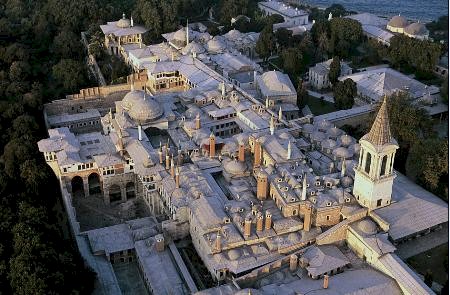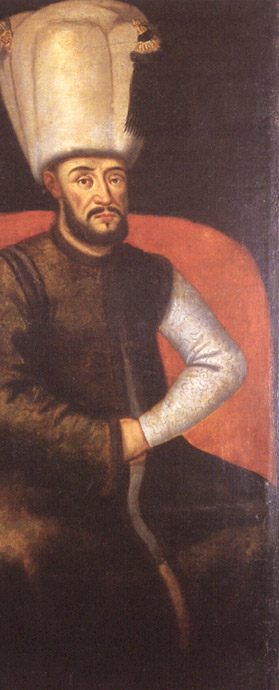 |
| Mustafa I |
http://en.wikipedia.org/wiki/Ahmed_I
To the left is Mustafa I.
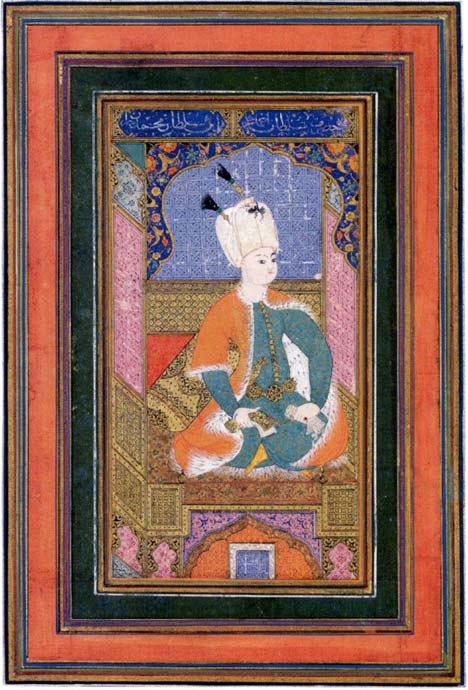 |
| Ahmed I |
sultan of the Ottoman Empire until dying from typhus in 1617, at the ripe old age of 27. Ahmed I had been sultan since the age of 13. It is recorded that he was intelligent and disciplined, precocious even, and was adept at a whole host of extracurriculars, including horseback riding, poetry, fencing, and multiple languages.
Mustafa, on the other hand, was described as either mentally retarded or "neurotic," depending on who you asked. Mustafa was locked in "Kafes," which kind of means the cage--this was a traditional way to minimize the potential for political intrigue related to succession and having multiple heirs to the Ottoman throne. It was the alternative to simply executing rivals, although this was also practiced.
 |
| Osman II |
It was short-lived, however.
A year into his reign, he was deposed by his nephew, Osman II, who had been groomed since birth by the late Ahmed I's Greek wife Maria. Osman had already become a noted poet, and was fluent in many languages.
Mustafa was again returned to Kafes, or you could call it the Cage-Safe, which is also one possible title for my filmed adaptation if it were to be directed by John Woo. Starring
| Jan Chodkiewicz |
Anyway, Osman returned to his country in shame. He chose to blame his troops, the Janissaries, an entrenched military elite, for the failure of the campaign. He began to lay the groundwork for a separate army, an ethnically Turkish army--a modern western army--to take the place of the Janissaries. He closed their coffee shops.
 Now, from what I can tell, these Janissaries had evolved over a few hundred years from being a fierce, loyalist fighting force, trained from childhood for battle, into a burdensome special social class, whose historical importance to the sultan had afforded it promises of pensions, property, and other privileges, which had ballooned over time.
Now, from what I can tell, these Janissaries had evolved over a few hundred years from being a fierce, loyalist fighting force, trained from childhood for battle, into a burdensome special social class, whose historical importance to the sultan had afforded it promises of pensions, property, and other privileges, which had ballooned over time.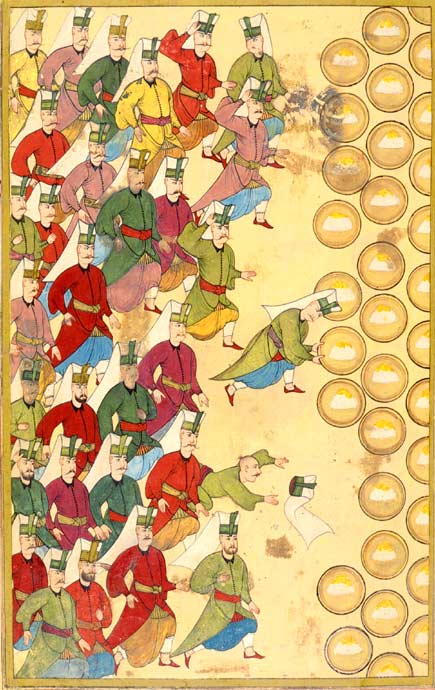
 By the time Osman was crowned, there was already a great deal of anti-Janissary sentiment among the other ruling classes. Traditionally, they were supposed to be fiercely loyal and obedient. They were the sultan's personal standing army. They were the elite bodyguards.
By the time Osman was crowned, there was already a great deal of anti-Janissary sentiment among the other ruling classes. Traditionally, they were supposed to be fiercely loyal and obedient. They were the sultan's personal standing army. They were the elite bodyguards.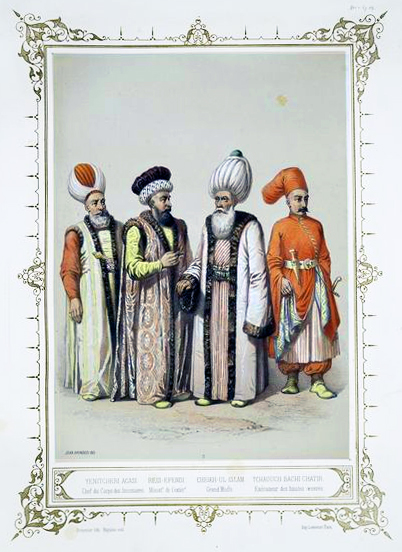 But they were in fact "door servants." Just above slaves, freedom-wise. Plucked from among the children of conquered foreigners, no less.
But they were in fact "door servants." Just above slaves, freedom-wise. Plucked from among the children of conquered foreigners, no less.By 1622, however, they were one of the main ruling factions. They could marry, run businesses, have families, property; they maintained growing salaries, benefits, training academies, et CETera. Kind of a mix of today's Republicans' and Democrats' worst nightmares!
Anyway, Osman closed their coffee shops. And so the palace janissaries flipped and took control of the palace. They were the palace guard, after all. They imprisoned Osman II in the legendary Castle of Seven Towers.
 | |
| Castle of Seven Towers |
Not soon after they decided to execute him.
Now, by all accounts, Osman put up quite a fight when the executioners went up to his room. Also, it seems likely that his testicles were crushed in some manner during the scuffle. One story has it that as the executioner tried to slip a bowstring around Osman's neck, the boy-man was able slip his hand up to block it before he could be choked. Kind of James Bond-style. After an intense struggle, the grand vizier (the sultan's highest minister, unfortunately also drawn from the ranks of the Janissaries) grabbed the boy by the balls and squeezed them until he passed out. Once unconscious, Osman was easily strangled and thusly executed. Another account suggests that his testicles were crushed by the vizier because this was a traditional form of execution for sultans. If that's the case, it's really a telling indicator of
Osman II's successor, well... Have you forgotten about Mustafa I yet? The poor guy's been sitting in his room this whole time. And as a consequence he's still very much alive. And so he becomes Sultan of the Ottoman Empire for a second time.
He takes a hard line against those who killed Osman II. He has them all executed. Bold stuff. But this aggressive posture is mitigated somewhat by Mustafa's belief that his nephew is still alive. There is a story about Mustafa I wandering the Topkapı Palace, the seat of the Ottoman Empire, knocking on doors and calling out for Osman's return.
Within one year, Mustafa is kicked off the throne again, this time in favor of another nephew, Murad IV. Murad is eleven years old. He eventually becomes a legendarily strong and vicious battle commander, the last of the Ottoman's "Warrior Sultans," who wields a 132-pound mace with one arm. Mustafa goes back to the cage-safe and there lives out the rest of his days--sixteen more years to be exact. He dies in 1639, one year before Murad IV dies. I suspect Murad had him killed to avoid a potential third crazy term...
 |
| Murad IV |
When Murad IV was about 18 or 19, he took full command, launching an aggressive campaign to consolidate his power. He feared a similar fate to his half-brother's, and not unreasonably. But this guy was brutal. He didn't just close down the coffee shops--he banned coffee! Also tobacco and alcohol.
And get this--he would patrol the streets of Istanbul himself, in plainclothes, to make sure his rules were being enforced. This guy was the secret shopper from Hell. If he personally encountered anybody smoking or drinking alcohol, he would bludgeon them to death right where they stood, with his gigantic mace.
Like I said, he died of cirrhosis of the liver at age 27, just as he had finished a string of impressive military conquests. Kind of like a bad lieutenant, breaking his own laws and bashing his own skulls. And rotting his guts out.
 |
| Ibrahim the Mad |
When Murad died his final directive was not obeyed. Ibrahim was elevated to Sultan and what followed was a bizarre eight-year reign of nonsense.
 I suspect Murad and Ibrahim's mother may have had something to do with this--recall that she had ruled the empire through Murad until his coming-of-age, and maintained great power even after. She had consented to the killing of three of her four other children, while allowing Ibrahim to live sequestered in the family cage.
I suspect Murad and Ibrahim's mother may have had something to do with this--recall that she had ruled the empire through Murad until his coming-of-age, and maintained great power even after. She had consented to the killing of three of her four other children, while allowing Ibrahim to live sequestered in the family cage. This concubine--another Greek originally married to Ahmed I, maiden name of Anastasia--flexed some serious muscle during her ongoing quest for power. It isn't out of the range of possibility that she'd always endeavored to keep Ibrahim in her back pocket should some unforseen opportunity arise. A mentally-deranged non-threat in the eyes of Murad IV, worthy of compassion or pity, perhaps... But a valuable potential pawn for Mom.
This concubine--another Greek originally married to Ahmed I, maiden name of Anastasia--flexed some serious muscle during her ongoing quest for power. It isn't out of the range of possibility that she'd always endeavored to keep Ibrahim in her back pocket should some unforseen opportunity arise. A mentally-deranged non-threat in the eyes of Murad IV, worthy of compassion or pity, perhaps... But a valuable potential pawn for Mom. In any event, the disastrous reign of Ibrahim the Mad includes a heap of marvelous anecdotes. Get this: Ibrahim loved fat women--the fatter the better. He sent out special "agents" to the far corners of his empire to find and bring back the fattest ladies in the land. One of them weighed over 330 pounds. When she showed up, Ibrahim named her "piece of sugar" and ordered that she receive a government pension. Then he named her Governor General of Damascus. The city.
Another time, when he became suspicious that someone else was having sex with his concubines, he drowned 280 of them in the Istanbul Strait. It is said that "piece of sugar" may have been responsible for these suspicions.
He fought constantly with the mother of Mehmed IV (his heir), a woman by the name of Turhan Hatice. Once he tore Mehmed out of Turhan's arms and threw him into a cistern. The baby was retrieved, but the incident scarred his head. I read another article that claims Ibrahim also stabbed his son in the face.
Turhan Hatice, or Nadia, as she was known in her native Ukraine, is another figure worthy of her very own blog post. She fought viciously with her mother-in-law, Anastasia, as both women sought to rule the Ottoman empire via her son Mehmed IV. At first Anastasia was granted regency over her grandson's affairs on account of Nadia's relative youth and inexperience. Both women plotted to kill each other. Anastasia even plotted to kill her own grandson just to cut Nadia out of the picture!
Eventually Nadia won by getting the palace harem's Chief Black Eunuch to strangle her mother-in-law with a curtain. Anastasia, like her son Osman II years before, apparently put up a hell of a fight. She also ran and tried to lose her attackers in the labyrinth of the palace harem. She hid in a cabinet, but a piece of her dress got caught in the door and she was discovered.
These stories of rulers being killed are particularly wrenching, and delicious, when the accounts suggest that the victims maintained some illusion of a hope of survival to the very bitter end.
 |
| Anastasia captured |
 |
| Harem life |
Heavy-duty stuff! But what else would you expect from the palace at the geographic center of world civilization?
And don't even get me started on how all of this plays out with respect to the fall of the empire, or to the spread of Islam, or to the spread of Quakerism (really! That's Mary Fisher, one of the "Valiant Sixty," preaching to Mehmed IV, there, under the tent!
)--you would be hard-pressed to invent such a wild and vivid and far-reaching epic. Oh yeah, and Ibrahim the Mad used to feed gold coins to his fish.
He lasted eight years, was deposed, then strangled.

Later, his successor, Mehmed IV, despite having suffered a major defeat in battle at the hands of the Zaporozhian Cossacks, continued to call for his enemy's surrender. Their official written reply, a vulgar, expletive-laden diatribe of the highest order, was immortalized in Russian artist Illya Repin's masterpiece, Reply of the Zaporozhian Cossacks to Sultan Mehmed IV of the Ottoman Empire:
...Seriously one of the greatest paintings ever--it's like Norman Rockwell went on sabbatical with the Cossacks in the 17th Century. It's also like how my filmed adaptation would look if I decided to go with a motion capture animation technique. The letter was such a zinger it warranted this monumental painting of its writing. And here is that letter, as it survives today, translated from the Ukrainian:
Zaporozhian Cossacks to the Turkish Sultan!
Thou art a turkish imp, the damned devil's brother and friend, and a secretary to Lucifer himself. What the devil kind of knight art thou that cannot slay a hedgehog with your naked arse? The devil shits, and your army eats. Thou a son of a bitch wilt not ever make subjects of Christian sons; we have no fear of your army, by land and by sea we will battle with thee, fuck thy mother.
Thou art the Babylonian scullion, Macedonian wheelwright, brewer of Jerusalem, goat-fucker of
Alexandria , swineherd of Greater and Lesser Egypt, Armenian pig, Podolian villain, catamite of Tartary, hangman of Kamyanets, and fool of all the world and underworld, a fool before our God, a grandson of the Serpent, and the crick in our dick. Pig's snout, mare's arse, slaughterhouse cur, unchristened brow, screw thine own mother!
So the Zaporozhians declare, you lowlife. Thou wilt not even be herding Christian pigs. Now we shall conclude, for we don't know the date and don't have a calendar; the moon's in the sky, the year in the book, the day's the same over here as it is over there; for this kiss our arse!
Koshovyi Otaman [hetman] Ivan Sirko, with the whole Zaporozhian Host
Knowledge! And check out Curious Expeditions - "The Silk Rope and the Golden Cage", a delectable article that goes more in-depth on some of the anecdotes I glossed over...
 |
| Islam and Istanbul |


